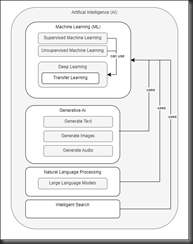Overview
Artificial Intelligence receives a lot of coverage in the scientific and popular press these days. You may have heard terms like "Machine Learning," "Deep Learning," "Transfer Learning," and "Generative AI" and wonder what they mean and what is the difference between each of them. Although not identical, all these concepts are related.
This article will discuss these terms, their definitions, and their relation.
Artificial Intelligence
Artificial Intelligence ("AI") is a broad term for getting computers to think like humans. This concept is at the top of all the others.
Machine Learning
Machine Learning ("ML") is a subset of Artificial Intelligence that describes algorithms that examine a set of data, group that data, and create a model that allows the computer to make predictions based on that model. It uses mathematics and statics in its work.
There are two basic types of Machine Learning: Supervised Machine Learning and Unsupervised Machine Learning.
With both ML types, each data point contains known attributes called "features" that can be used to make predictions. These will be the inputs that we will pass into a model.
In Supervised Machine Learning, each data point has labels in addition to features. A label is an attribute that we want the model to predict. It is the output when we use our model. The algorithm seeks to find the relationship between the features and the labels and builds a model that allows us to predict the value of one or more labels given a set of features. For example, we may have data containing online advertising features (date posted, site on which it appears, time of day, size of the ad, etc.) along with click-through rates, which would be our feature. After building a model from this data, we can predict a click-through rate based on an ad we plan to place.
In Unsupervised Machine Learning, the data has features, but no labels, so the algorithm focuses on clustering together data points with similar features. An example might be grouping images of cats into different breeds. After building a model from this image data, we can provide a new picture of a cat and ask which breed it most closely resembles.
In both Supervised and Unsupervised Learning, a Data Scientist can choose from various algorithms to build their model.
Deep Learning
Deep Learning is a subset of Machine Learning designed to solve complex problems. With deep learning, we still provide data on which to build a model; but our algorithm contains multiple layers. The output of one layer is the input of the next layer. Because of the complexity of these problems and the requirement for multiple layers, Deep Learning requires more computing power and processing time. For complex problems, Supervised and Unsupervised Machine Learning may use Deep Learning.
Transfer Learning is related to Deep Learning. With Transfer Learning, we take advantage of other Deep Learning algorithms and reuse the output of Layers we already executed as input for one or more of our Deep Learning layers. Transfer Learning reduces the amount of computing resources and time required.
Natural Language Processing
Artificial Intelligence allows computers to understand human languages, such as English, Spanish, or Arabic. By building a model based on human communications, AI systems can understand a statement or question presented in various ways, along with the context of that text. Tools like ChatGPT use Large Language Models (LLMs) to build a model that allows users to interact similar to how humans communicate. Natural Language Processing often uses Machine Learning to build its models.
Intelligent Search
Computers have long had the ability to search text data. One big challenge is determining the context of a search, particularly when a word or phrase has multiple meanings. Artificial Intelligence can infer that context from when and where the search initiates. When writing a paper about England, the term "Bath" is more likely to refer to the city in Somerset, UK than a tub where people cleanse themselves. Search engines like Google and Bing use AI to attempt to determine the context of a search, but tools like Azure Cognitive Search allow you to index your internal data intelligently. Intelligent Search often uses Machine Learning to build its models.
Generative AI
Generative AI is a type of Artificial Intelligence that focuses on creating content. Models built from existing data are used to generate new assets. This technology can be used to create images, text, or audio. Machine Learning or Deep Learning may be used to build the models to create these assets. OpenAI has developed two tools for creating OpenAI. ChatGPT generates text from input queries using a Large Language Model, while Dall-E generates images from an input description.
Fig. 1 shows the relationship between the concepts described above.
Conclusion
In this article, I described some important concepts in Artificial Intelligence and how they relate to one another.
